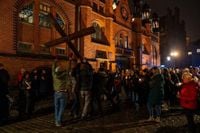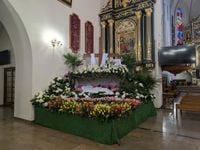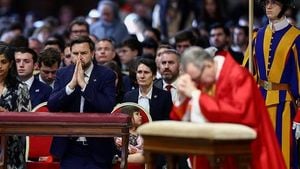The Triduum Paschalne, a significant three-day event in the Christian liturgical calendar, commences on April 17, 2025, with Wielki Czwartek, or Holy Thursday. This sacred period commemorates the Last Supper, during which the sacraments of the Eucharist and priesthood were established.
On the morning of April 17, all cathedral churches will witness the diocesan bishop, accompanied by priests, celebrating the Chrism Mass. This important liturgy involves the consecration of oils used for anointing the sick and for baptism, marking a vital moment in the church's sacramental life.
As the day progresses, the evening Mass of the Lord's Supper will take place, officially inaugurating the solemn celebration of the Triduum Paschalne. This Mass is steeped in tradition, beginning with the hymn 'Glory to God in the Highest' and featuring the poignant ritual of foot washing, where the priest may wash the feet of twelve men, symbolizing humility and service, much like Jesus did for His disciples.
At the end of the Mass, the Blessed Sacrament is transferred to a designated area known as the 'Ciemnica,' a place of repose that reflects the somber nature of the events to follow.
Moving into Wielki Piątek, or Good Friday, on April 18, the liturgy takes on a unique character, as no Eucharist is celebrated. Instead, the day is marked by deep reflection on the passion and death of Jesus Christ, a focal point of the Triduum. The faithful engage in the Stations of the Cross, typically held at 3 PM, and participate in the Liturgy of the Lord's Passion, which begins with the celebrant lying prostrate before the altar as a sign of reverence.
During this solemn liturgy, the Passion of the Lord according to St. John is read, followed by the veneration of the cross, where worshippers may express their devotion through acts of adoration. The atmosphere is intentionally quiet, with no musical accompaniment, and the sounds of rattles replace the usual ringing of bells, symbolizing mourning and reflection.
Wielki Piątek also features the tradition of praying at the Groby Panskie, or Tombs of the Lord. This custom, which dates back to Palestine, involves creating tomb-like displays in churches. In Poland, since the 16th century, a figure of the deceased Jesus and the monstrance containing the Blessed Sacrament, covered with a veil, are placed at the center, representing the burial of Christ.
As the day concludes, the faithful continue to keep vigil at the tombs until the Easter Vigil, which occurs on Wielka Sobota, or Holy Saturday, April 19, 2025. This day is marked by silence and anticipation, as it follows the death of Jesus. In line with tradition, priests bless food items, including bread, meat, and eggs, which are later shared on Easter Sunday.
The Easter Vigil, celebrated in the evening of April 19, represents the transition from death to new life through the resurrection of Christ. This liturgy is rich in symbolism and is structured into four main parts: the liturgy of light, the liturgy of the word, the baptismal liturgy, and the Eucharistic liturgy. The Vigil is a profound celebration, culminating in the solemn Eucharist and a Resurrection procession.
Finally, on Niedziela Zmartwychwstania, or Easter Sunday, April 20, the joyous celebration of Christ's resurrection begins after sunset on Holy Saturday. The Vigil concludes with a grand procession, and the ringing of bells announces the victory of life over death, a powerful reminder of the core message of Easter.
As Bishop Piotr Greger, chairman of the Committee for Divine Worship and the Discipline of the Sacraments, emphasizes, the Triduum Paschalne is a culmination of the liturgical year, encapsulating the mystery of redemption through the passion, death, and resurrection of Christ. It is a time filled with rich gestures and symbols that have developed over centuries, making the experience of these liturgies deeply meaningful for the faithful.
In Poland, the Triduum Paschalne is not just a series of events but a profound journey through the symbols of salvation, allowing participants to reflect on the significance of the Last Supper, the crucifixion, and the resurrection. Each ritual, each gesture, serves to deepen the understanding of the Christian faith and the central mysteries it encompasses.
The Triduum Paschalne, therefore, stands as a pivotal moment for Christians, a time to engage with the core tenets of their faith through rich, symbolic liturgies that resonate with the essence of salvation history.






